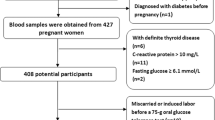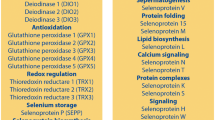Abstract
There is an increased requirement for selenium during pregnancy, presumably for fetal growth, which manifests as decreasing maternal blood and tissue selenium concentrations. These decreases are greater in pregnant women with gestational or preexisting diabetes. We measured selenium status and glucose tolerance between wk 12 and 34 of gestation in 22 pregnant women. We found that the increase in blood glucose in response to an oral glucose challenge at 12 wk gestation and the increase in fasting glucose during pregnancy were inversely correlated with plasma selenium concentration. Women with lower plasma glutathione peroxidase activities during pregnancy also tended to have higher fasting glucose levels. These inverse relationships between selenium status and glucose tolerance are consistent with earlier observations that suggest a link between selenium and glucose metabolism. The observation that changes in serum glucose were not accompanied by changes in insulin suggests that selenium may affect glucose metabolism downstream from insulin, or through independent energy regulatory pathways such as thyroid hormone.
Similar content being viewed by others
References
N. D. McGlashan, S. J. Cook, W. Melrose, P. L. Martin, E. Chelkowska, and R. J. von Witt, Maternal selenium levels and sudden infant death syndrome (SIDS), Aust. N. Z. J. Med. 26, 677–682 (1996).
J. A. Butler, P. D. Whanger, and M. J. Tripp, Blood selenium and glutathione peroxidase activity in pregnant women comparative assays in primates and other animals, Am. J. Clin. Nutr. 36, 15–23 (1982).
L. J. Hinks, S. A. Ogilvy, K. M. Hambidge, and V. Walker, Maternal zinc and selenium status in pregnancies with a neural tube defect or elevated plasma alpha fetoprotein, Br. J. Obstet. Gynaecol. 96, 61–66 (1989).
B. A. Zachara, C. Wardak, W. Didkowski, A. Maciag, and E. Marchaluk, Changes in blood selenium and glutathione concentrations and glutathione peroxidase activity in human pregnancy, Gynecol. Obstet., Invest. 35, 12–17 (1993).
E. Ferrer, A. Alegria, R. Barbera, R. Farre, M. J. Lagarda, and J. Monleon, Whole blood selenium content in pregnant women, Sci. Total Environ. 227, 139–143 (1999).
M. Navarro, H. Lopez, V. Perez, and M. C. Lopez, Serum selenium levels during normal pregnancy in healthy Spanish women, Sci. Total Environ. 186, 237–242 (1996).
W. Wasowicz, P. Wolkanin M. Bednarski, J. Gromadzinska, M. Sklodowska, and K. Grzybowska, Plasma trace element (Se, Zn, Cu) concentrations in maternal and umbilical cord blood in Poland—relation with birth weight, gestational age, and parity, Biol. Trace Elem. Res. 38, 205–215 (1993).
J. Gromadzinska, W. Wasowicz, G. Krasomski, et al., Selenium levels, thiobarbituric acid-reactive substance concentrations and glutathione peroxidase activity in the blood of women with gestosis and imminent premature labour, Analyst 123, 35–40 (1998).
J. A. Butler and P. D. Whanger, Metabolism of selenium by pregnant women, J. Trace Elem. Exp. Med. 5, 175–188 (1992).
W. C. Hawkes, F. Z. Alkan, and L. Oehler, Absorption, distribution and excretion of selenium from beef and rice in healthy North American men, J. Nutr. 133, 3434–3442 (2003).
H. Guvenc, F. Karatas, M. Guvenc, S. Kunc, A. D. Aygun, and S. Bektas, Low levels of selenium in mothers and their newborns in pregnancies with a neural tube defect, Pediatrics 95, 879–882 (1995).
R. Karunanithy, A. C. Roy, and S. S. Ratnam, Selenium status in pregnancy studies in amniotic fluid from normal pregnant women, Gynecol. Obstet. Invest. 27, 148–150 (1989).
C. A. Swanson, D. C. Reamer, C. Veillon, J. C. King, and O. A. Levander, Quantitative and qualitative aspects of selenium utilization in pregnant and nonpregnant women: an application of stable isotope methodology, Am. J. Clin. Nutr. 38, 169–180 (1983).
M. P. Rayman, P. Bode, and C. W. Redman, Low selenium status is associated with the occurrence of the pregnancy disease preeclampsia in women from the United Kingdom, Am. J. Obstet. Gynecol. 189, 1343–1349 (2003).
D. Bonnefont-Rousselot, Glucose and reactive oxygen species, Curr. Opin. Clin. Nutr. Metab. Care 5, 561–568 (2002).
R. K. Sundaram, A. Bhaskar, S. Vijayalingam, M. Viswanathan, R. Mohan, and K. R. Shanmugasundaram, Antioxidant status and lipid peroxidation in type II diabetes mellitus with and without complications Clin. Sci. 90, 255–260 (1996).
A. Ceriello, N. Bortolotti, A. Crescentini, et al., Antioxidant defences are reduced during the oral glucose tolerance test in normal and non-insulin-dependent diabetic subjects, Eur. J. Clin. Invest. 28, 329–333 (1998).
M. J. Bunk and G. F. Combs, Jr., Relationship of selenium-dependent glutathione peroxidase activity and nutritional pancreatic atrophy in selenium-deficient chicks, J. Nutr. 111, 1611–1620 (1981).
J. M. Braganza, C. D. Hewitt, and J. P. Day, Serum selenium in patients with chronic pancreatitis lowest values during painful exacerbations, Trace Elem. Med. 5, 79–84 (1988).
S. Uden, D. Bilton, L. Nathan, L. P. Hunt, C. Main, and J. M. Braganza, Antioxidant therapy for recurrent pancreatitis placebo-controlled trial, Aliment. Pharmacol. Ther. 4, 357–372 (1990).
C. D. Eckhert, M. K. Lockwood, and B. Shen, Influence of selenium on the microvasculature of the retina, Microvasc. Res. 45, 74–82 (1993).
D. J. Becker B. Reul, A. T. Ozcelikay, J. P. Buchet, J. C. Henquin, and S. M. Brichard, Oral selenate improves glucose homeostasis and partly reverses abnormal expression of liver glycolytic and gluconeogenic enzymes in diabetic rats, Diabetologia 39, 3–11 (1996).
M. L. Battell, H. L. Delgatty, and J. H. McNeill, Sodium selenate corrects glucose tolerance and heart function in STZ diabetic rats, Mol. Cell. Biochem. 179, 27–34 (1998).
J. L. Schlienger, F. Grunenberger, E. A. Maier, C. Simon, G. Chabrier, and M. J. F. Leroy, Disturbances of plasma trace elements in diabetes relations with glycemic control, Presse Med. 17, 1076–1079 (1988).
S. Yadav, J. P. Day, V. Mohan, C. Snehalatha, and J. M. Braganza, Selenium and diabetes in the tropics, Pancreas 6, 528–533 (1991).
M. Simonoff, C. Conri, B. Fleury, et al., Serum and erythrocyte selenium in normal and pathological states in France, Trace Elem. Med. 5, 64–69, (1988).
M. Tan, L. Sheng, Y. Qian, et al., Changes of serum selenium in pregnant women with gestational diabetes mellitus, Biol. Trace Elem. Res. 83, 231–237 (2001).
A. Farhat, M. F. Picciano, C. J. Lammikeefe, and H. N. Desilva, Evidence for altered selenium status in pregnant women with diabetes, J. Trace Elem. Exp. Med. 8, 29–39 (1995).
C. D. Eckhert and K. Woolf, Low selenium status in women with gestational diabetes, FASEB J. 6, (1992).
M. D. Van Loan, N. L. Keim, and A. Z. Belko, Body composition assessment of a general population using total body electrical conductivity (TOBEC), in Sports, Medicine and Health, Excerpta Medica International Congress Series No. 921, G. P. H. Hermans and W. I. Mosterd, eds., Elsevier Science Publishers, Amsterdam, pp. 665–670 (1990).
M. D. Van Loan, L. E. Kopp, J. C. King, W. W. Wong, and P. L. Mayclin, Fluid changes during pregnancy: use of bioimpedance spectroscopy, J. Appl. Physiol. 78, 1037–1042 (1995).
J. H. Watkinson, Fluorometric determination of selenium in biological material with 2,3-diaminonaphthalene, Anal. Chem. 38, 92–97 (1966).
W. C. Hawkes and M. A. Kutnink, High-performance liquid chromatographic-fluorescence determination of traces of selenium in biological materials, Anal. Biochem. 241, 206–211 (1996).
D. E. Paglia and W. N. Valentine, Studies on the quantitative and qualitative characterization of erythrocyte glutathione peroxidase, J. Lab. Clin. Med. 70, 158–169 (1967).
X. Chen, T. O. Scholl, M. J. Leskiw, M. R. Donaldson, and T. P. Stein, Association of glutathione peroxidase activity with insulin resistance and dietary fat intake during normal pregnancy, J. Clin. Endocrinol. Metab. 88, 5963–5968 (2003).
K. Mahomed, Iron and folate supplementation in pregnancy, Cochrane Database Syst. Rev. CD001135 (2000).
N. L. Sloan, E. Jordan, and B. Winikoff, Effects of iron supplementation on maternal hematologic status in pregnancy Am. J. Public Health 92, 288–293 (2002).
E. B. Dawson and W. J. McGanity, Protection of maternal iron stores in pregnancy, J. Reprod. Med. 32, 478–487 (1987).
A. Bashiri, E. Burstein, E. Sheiner, and M. Mazor, Anemia during pregnancy and treatment with intravenous iron: review of the literature, Eur. J. Obstet Gynecol. Reprod. Biol. 110, 2–7 (2003).
J. Bransova, A. Brtkova, E. Sebokova, I. Klimes, P. Langer, and J. Brtko, Diet-induced insulin resistance is associated with decreased activity of type I iodothyronine 5′-deiodinase in rat liver, Ann. N. Y. Acad. Sci. 827, 485–488 (1997).
D. Mentuccia, L. Proietti-Pannunzi, K. Tanner, et al., Association between a novel variant of the human type 2 deiodinase gene Thr92Ala and insulin resistance: evidence of interaction with the Trp64Arg variant of the beta-3-adrenergic receptor, Diabetes 51, 880–883 (2002).
C. J. Torrance, J. E. Devente, J. P. Jones, and G. L. Dohm, Effects of thyroid hormone on GLUT4 glucose transporter gene expression and NIDDM in rats, Endocrinology 138, 1204–1214 (1997).
M. L. Furtado, V. Poon, and A. Klip, GLUT4 activation: thoughts on possible mechanisms, Acta Physiol. Scand. 178, 287–296 (2003).
N. Viguerie, L. Millet, S. Avizou, H. Vidal, D. Larrouy, and D. Langin, Regulation of human adipocyte gene expression by thyroid hormone, J. Clin. Endocrinol. Metab. 87, 630–634 (2002).
M. Foretz, C. Guichard, P. Ferre, and F. Foufelle, Sterol regulatory element binding protein-1c is a major mediator of insulin action on the hepatic expression of glucokinase and lipogenesis-related genes, Proc. Natl. Acad. Sci. USA 96, 12737–12742 (1999).
N. P. Koritschoner, M. Alvarez-Dolado, S. M. Kurz, et al., Thyroid hormone regulates the obesity gene tub, EMBO Rep. 2, 499–504 (2001).
Y. Iizuka, E. Sakurai, and N. Hikichi, Effects of selenium on the serum glucose and insulin levels in diabetic rats, Folia Pharmacol. Jpn. 100, 151–156 (1992).
C. Douillet, A. Tabib, M. Bost, M. Accominotti, F. Borson-Chazot, and M. Ciavatti, Selenium in diabetes: Effects of selenium on nephropathy in type I streptozotocin-induced diabetic rats, J. Trace Elem. Exp., Med. 12, 379–392 (1999).
A. S. Mueller, J. Pallauf, and J. Rafael, The chemical form of selenium affects insulinomimetic properties of the trace element: investigations in type II diabetic dbdb mice, J. Nutr. Biochem. 14, 637–647 (2003).
M. R. L'abbe and K. D. Trick, Changes in pancreatic glutathione peroxidase and superoxide dismutase activities in the prediabetic diabetes-prone BB rat, Proc. Soc. Exp. Biol. Med. 207, 206–212 (1994).
B. Mukherjee, S. Anbazhagan, A. Roy, R. Ghosh, and M. Chatterjee, Novel implications of the potential role of selenium on antioxidant status in streptozotocin-induced diabetic mice, Biomed. Pharmacother. 52, 89–95 (1998).
Author information
Authors and Affiliations
Rights and permissions
About this article
Cite this article
Hawkes, W.C., Alkan, Z., Lang, K. et al. Plasma selenium decrease during pregnancy is associated with glucose intolerance. Biol Trace Elem Res 100, 19–29 (2004). https://doi.org/10.1385/BTER:100:1:019
Received:
Accepted:
Issue Date:
DOI: https://doi.org/10.1385/BTER:100:1:019




